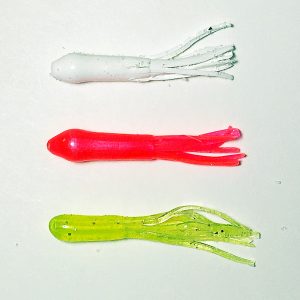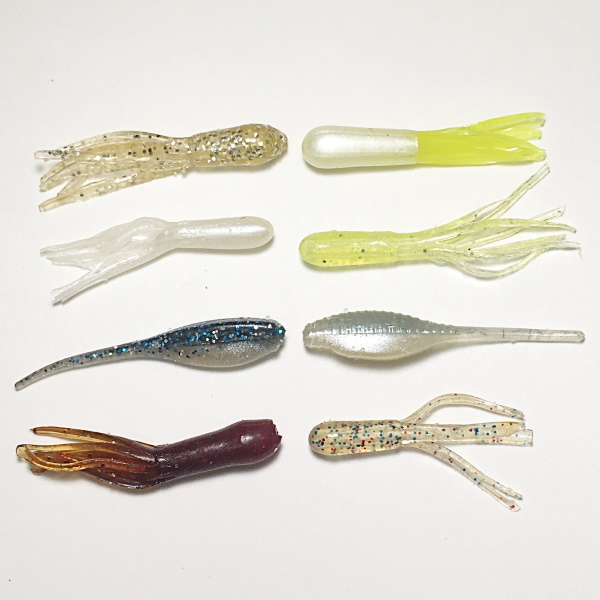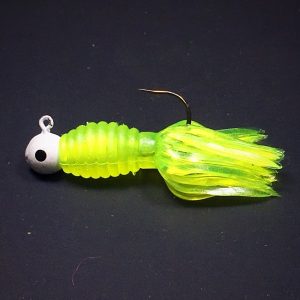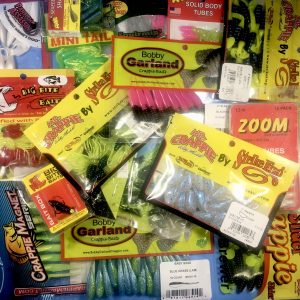After crappie fishing for 20+ years, I still remember how tough it was to choose jig colors in the beginning. My goal is to speed that process up for you.
Below, in no particular order, is my list of the best crappie jig colors. You’ll notice a few repeats, and that’s no mistake. Some colors do indeed work well in both stained and clear waters. If you’d like to learn more about when to use certain colors, keep reading.

Crappie Jig Colors For Stained Water
- Solid Colors
- Opaque Colors
- Dark Colors
- Black
- Pink
- White
- Black/Pink
- Black/Chartreuse
- Blue/Chartreuse
- Red/Chartreuse
- Orange/Chartreuse
- Gold/Chartreuse
- Lime/Chartreuse
- Blue/White
- Pink/White
- Bobby Garland Cajun Cricket
- Bobby Garland Glacier
- Bobby Garland Outlaw Special
Crappie Jig Colors For Clear Water
- Natural Colors
- Translucent Colors
- Subdued Colors
- White
- Chartreuse
- White/Chartreuse
- Blue/Clear
- Motor Oil
- Brown
- With Or Without Glitter Flakes
- Bobby Garland Monkey Milk
- Bobby Garland Glacier
- Bobby Garland Blue Ice
What Do Crappie Actually Eat?
A crappie’s diet consists mainly of small gray, or silver colored fish. Of course, that’s not all they eat. But, that’s the dominant forage, and is what you should most often try to mimic.
Crappie also eat crawfish, insects, worms, and many other random things.
Eating things having all sorts of colorations is normal for a Crappie.
Color Matters Because Crappie Are Sight Feeders
Crappie are sight feeders, and appear to be more sensitive to color preferences than most other fish I have targeted.
With that said, you should also know that many of the strangely colored jigs you see in stores are actually going to appear as some shade of gray or silver when viewed underwater. This is even more true in dirty and stained water. If you don’t believe me, fill up a large glass jar with dirty lake water, and drop some flashy colored lures in to see for yourself.
Crappie Can Be Very Finicky About Colors
Over the years, I’ve noticed that color preferences can be extremely subtle for crappie. One slight variation in color combination can drastically change your catch rate compared to your buddy sitting right beside you.
A crappie’s sensitivity to colors is why I like jigs so much. You have 4 or more pieces of your bait that you can use to tweak the color – jig head, jig body, jig tail and hook color. Don’t be afraid to experiment.
Three Primary Crappie Jig Colors To Build Your Arsenal Around
As I see it, there are 3 colors that need to be in every crappie fisherman’s tacklebox. This should be your starting point.
- White
- Pink
- Chartreuse

Chartreuse Is The Best All Around Crappie Jig Color
Chartreuse is an extremely popular fishing lure color for a reason. Not only does it look like a fish underwater, it also works in both clear and stained water. Chartreuse is a color you definitely need in your arsenal.
Even if I don’t go all in with a solid chartreuse jig, I’ll often have it somewhere in my setup. White/Chart, pink/chart, black/chart, red/chart and blue/chart are all really good combos. Certainly on a new body of water, I’m always going to give chartreuse a try.
No matter what the conditions or water clarity are, it’s hard to beat a chartreuse crappie jig. That’s always a good color to start with, as it sort of becomes more of a fish-looking white color underwater.
White Is A Great Crappie Jig Color
While I admit, white isn’t the sexiest fishing lure color, it just plain works. The reason is obvious, as most bait fish have some shade of white in their coloration. A white jig body with a chartreuse tail is one of my most used colors.
White is a good color in both clear and dingy water.
Pink Is My Number 3 Color
Any crappie fisherman with any level of experience knows that pink is a great crappie jig color.
Pink is another color I often mix in with other proven colors. Black/pink, chartreuse/pink, blue/pink and pink/white are all good colors.
Other Good Crappie Jig Colors
Branching away from my top 3, other good colors for crappie are pink, yellow, green, black, red and blue. The number of possible crappie jig color combinations can make your head spin.
A lot of it comes down to your own confidence in certain colors that you “know” will be successful.
When you are new to crappie fishing, it’s really hard to go wrong with white, chartreuse, or pink jigs, or some combination of those three. But, I also like to throw in some black, blue, or orange as a contrasting color in stained water.
Two of my personal favorite color combos for stained water crappie are a lead head/blue body /white tail and an orange jig head with a chartreuse body. For clear water I typically rotate among the colors in the list shown above.
Colors Appear Differently Underwater Than On The Store Shelves
Now that we have identified some good crappie colors, you might wonder why in the world would pink, chartreuse and other such unnatural colors fool a crappie. Without delving too deep, the simple answer is that jig colors appear differently underwater than how you see them on the shelf. This is particularly true in stained or deeper water.
Much of what different colors look like underwater are different shades of white and gray. So, a lot of what different colors actually accomplish for us is to give us a particular “shade” of a fish-like color that can be seen well by the fish while still looking similar to what they are feeding on.
Chartreuse is a perfect example of a crazy looking color that works well. Ever wonder why chartreuse is such a popular lure color? It’s partly because it has the yellow tint common to certain sunfish, but also because the “brightness” helps the lure stand out while still appearing natural. The crazy yellow color fades to a more muted fish-like color underwater. The same goes for pink.

Some General Color Selection Rules For Crappie
- Use a color that’s actually visible in the color of water you are fishing.
- Use colors that mimic what crappie are already feeding on.
- In stained water, go dark or very opaque bright. The more stained the water is, the better dark colored jigs work. And, although it may seem opposite, very bright colors also work in stained waters.
- In clear water, use mostly natural colors. Whites, grays, browns, and yes, even chartreuse.
- Use translucent colors in clear water.
Try Using Bright Colors For The Spawn
During the spawn, when fish are more aggressive, that’s a good time to tie on really bright colors. At this time of the year, sometimes the more fish you can get to see your bait, the better.
You’ll notice on store shelves, there are many different shades of the same colors. The spawn is when I’ll try the brighter shades of already proven colors. So, really bright shades of orange, chartreuse, or bright pinks are good options this time of year.

Some Bodies Of Water Do Have A Best Color
It is true that some lakes do seem to have a few colors that are “best”. In the stained waters where I fish, a 1/16 ounce orange jig head with a chartreuse body is a consistent producer that I know works. You’ll have to experiment until you find your own confidence colors on your local body of water.
When jigging for crappie, many people hold two poles at a time – one in each hand. As a starting point, It’s hard to go wrong with a simple white or chartreuse jig with a white or lead head. Tie that onto one pole, then use the 2nd pole to experiment with various colors. This will let you catch fish while still experimenting until you find some colors that work best on your home lake.
My personal preference is to use 3-6 poles in rod holders. That lets me try many colors at once.
Color Preference Can Change By Time Of Day, And By Depth
Color preferences can even vary throughout the same day, depending on how bright it is, as well as how deep you’re fishing.
If you’re not getting bit on a color you were using earlier in the day, or at a different depth, don’t be scared to keep changing until you find one they like. The lighting from a different time of day, or when cloud cover moves in can influence color preferences.
This ever changing nature of color preference is a good reason to use a multicolored jig. That way, if one color stops attracting, maybe the other one will draw interest.
Some Colors Hold Onto Their Color Better Than Others
Red Fades Fast
Red, for example, fades out first. This is why you’ll see red crappie fishing line on the store shelves. The thought is that red line disappears quickly under water, and therefore is invisible to fish.
Chartreuse Fades Too
Chartreuse is another color that fades rather quickly underwater, therefore it doesn’t look so “crazy” when viewed beneath the waters surface. Instead, it very much replicates the coloration of a bait fish.
Blue Holds Onto It's Color
Conversely, some colors hold onto their color better under water. Blue holds its color very well. Since blue is a desirable tone, or hue, when it comes to bait, it’s a popular crappie jig color. Blue/Chart, Blue/White and Blue/Clear are all really productive colors for me.
Black Contrasts Really Well
Black obviously contrasts well under water, but it still looks natural. Lots of things a crappie eats have a black coloration on them. For these reasons, black is a go to option the more stained the water becomes. At a certain point, you just want the fish to be able to see your jig at all. That’s where Black really shines. You’ll find that black/chartreuse is an extremely popular jig color.
When Should I Use Specks And Flakes In My Crappie Baits?
Flecks and sparkles help to mimic the natural flash of a bait fish. They help you more so when the sun is out, and when you’re fishing water clear enough for light to penetrate. So, in deep muddy water, I don’t see the point in using a sparkly bait. I like to use sparkly baits in shallow, lightly stained water when the sun is shining.
Opaque Vs Translucent Colors
Simply put, opaque colors are better in stained and muddy waters. They help jigs to contrast well under water so that crappie can see them from a distance.
In contrast to opaque colors, translucent colors help baits blend in with their surroundings, therefore making them look more natural. Translucent colors work better in clear water, as they look more natural.
The Color-C-Lector
You always have the option to buy confidence, sort of. You can purchase a Color-C-Lector, which is a contraption that tells you what colors are currently most visible in the water you’re fishing. So, it’s not going to tell you necessarily what color the fish will hit, but rather what’s most visible. And, visibility is one of the key factors in getting bit.
The Color-C-Lector gets mixed reviews, and I’ve never tried one. But, there seems to be enough evidence out there that it works for what it’s designed to do. Just don’t expect it to be a magic bullet.
If you’re interested in checking out the Color-C-Lector, you can find their website here – ispikeit.com
Conclusion
When I first started crappie fishing, it was tough deciding which colors to buy. I usually relied on advice from my buddy, who was about as clueless as me. With such little confidence in what we were doing, oftentimes we just resorted to sticking to a minnow on a hook. Any dummy can catch crappie with minnows, and dummies we were, at least when it came to crappie.
As we gained experience, we began to settle on certain colors that consistently produced on our home lake. In hindsight, it would have been helpful to have a better starting point.
Hopefully this article will help guide you, as you purchase your first rounds of crappie jigs.
My parting advice would be to start with chartreuse, white, and pink. Then, you can branch out from there.
If you like this article, check out my breakdown of the best 3 crappie baits.
Now, go buy some jigs!
Augustus Clay



